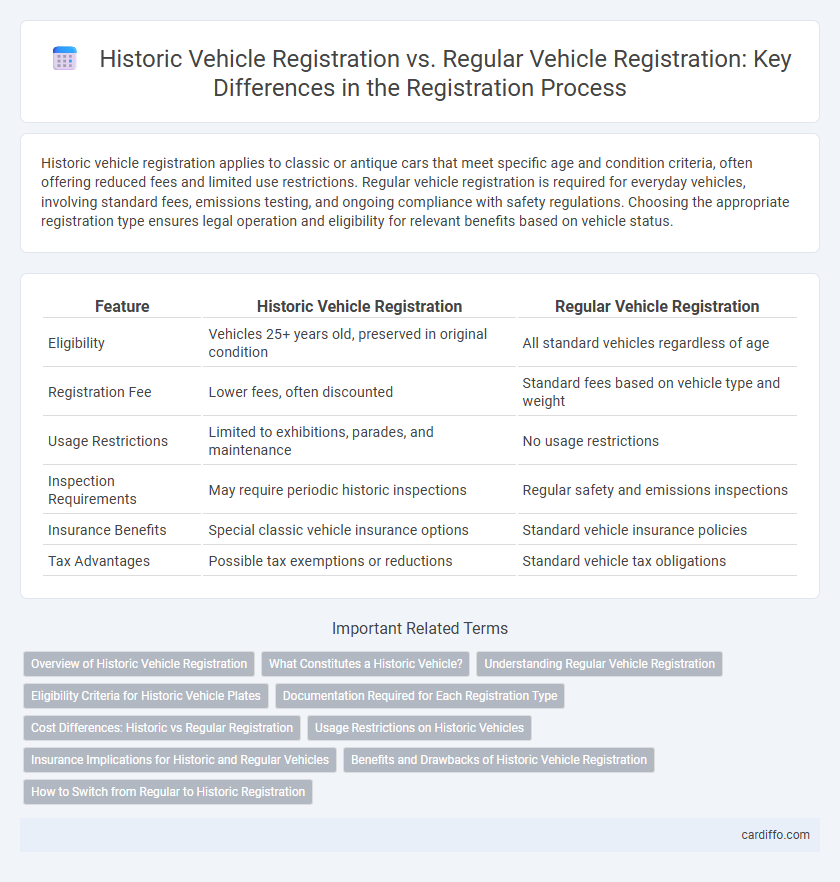Historic vehicle registration applies to classic or antique cars that meet specific age and condition criteria, often offering reduced fees and limited use restrictions. Regular vehicle registration is required for everyday vehicles, involving standard fees, emissions testing, and ongoing compliance with safety regulations. Choosing the appropriate registration type ensures legal operation and eligibility for relevant benefits based on vehicle status.
Table of Comparison
| Feature | Historic Vehicle Registration | Regular Vehicle Registration |
|---|---|---|
| Eligibility | Vehicles 25+ years old, preserved in original condition | All standard vehicles regardless of age |
| Registration Fee | Lower fees, often discounted | Standard fees based on vehicle type and weight |
| Usage Restrictions | Limited to exhibitions, parades, and maintenance | No usage restrictions |
| Inspection Requirements | May require periodic historic inspections | Regular safety and emissions inspections |
| Insurance Benefits | Special classic vehicle insurance options | Standard vehicle insurance policies |
| Tax Advantages | Possible tax exemptions or reductions | Standard vehicle tax obligations |
Overview of Historic Vehicle Registration
Historic vehicle registration applies to vehicles typically over 25 years old, preserving their original condition and limiting their use primarily for exhibitions, parades, and maintenance. This specialized registration often offers benefits such as reduced fees, relaxed emissions standards, and exemption from certain regular vehicle regulations. It emphasizes the preservation of automotive heritage while providing a distinct legal status separate from regular vehicle registration.
What Constitutes a Historic Vehicle?
A historic vehicle is typically defined as a motor vehicle that is at least 25 years old and maintained in its original or restored condition, reflecting its historical significance and automotive heritage. These vehicles are often exempt from certain regulations and taxes applicable to regular vehicles due to their limited use and collectible status. Registration of historic vehicles usually requires proof of age, originality, and a declaration of intended usage for preservation rather than daily transportation.
Understanding Regular Vehicle Registration
Regular vehicle registration requires submitting proof of ownership, current insurance, and passing safety and emissions inspections specific to the jurisdiction. This type of registration grants the vehicle legal permission for daily road use, ensuring compliance with traffic laws and regulations. Annual renewal typically involves updated fees and documentation to maintain valid registration status.
Eligibility Criteria for Historic Vehicle Plates
Historic vehicle registration requires that the vehicle be at least 25 years old and maintained in a condition consistent with its original design, whereas regular vehicle registration applies to all passenger vehicles regardless of age. Eligibility criteria for historic vehicle plates often include restrictions on vehicle usage, such as limited annual mileage and participation in exhibitions or club events. The application process for historic plates usually demands proof of the vehicle's age, ownership history, and compliance with specific state or regional regulations.
Documentation Required for Each Registration Type
Historic vehicle registration requires proof of the vehicle's age, such as a manufacturing date certificate, and documentation verifying the vehicle's original or restored condition, often including a notarized affidavit or restoration records. Regular vehicle registration demands a valid title, proof of ownership, emissions compliance documents, and current insurance verification. Both types typically require government-issued identification, completed application forms, and payment of registration fees specific to the registration category.
Cost Differences: Historic vs Regular Registration
Historic vehicle registration typically costs significantly less than regular vehicle registration due to reduced fees and lower taxes, reflecting the limited use and preservation status of classic cars. Regular vehicle registration fees are generally higher as they account for factors like vehicle weight, engine size, emissions compliance, and usage frequency. Cost savings for historic registrations are enhanced by eligibility for specialized discounts and exemptions unavailable to everyday vehicles, making classic car ownership more affordable.
Usage Restrictions on Historic Vehicles
Historic vehicle registration imposes specific usage restrictions, allowing the vehicle to be driven primarily for exhibitions, parades, or maintenance rather than daily commuting. Unlike regular vehicle registration, which permits unrestricted road use, historic plates often limit mileage and geographic areas to preserve automotive heritage. These restrictions help maintain the vehicle's condition and ensure compliance with specialized insurance and emission standards.
Insurance Implications for Historic and Regular Vehicles
Historic vehicle registration often results in lower insurance premiums due to limited usage and specialized coverage tailored to classic cars. Regular vehicle registration demands comprehensive insurance reflecting daily use, higher mileage, and broader risk exposure. Insurers typically assess historic vehicles based on rarity and preservation, while regular vehicles are evaluated on driver history and usage intensity.
Benefits and Drawbacks of Historic Vehicle Registration
Historic vehicle registration offers benefits such as lower fees, reduced insurance costs, and exemptions from certain emissions and safety inspections, making it ideal for classic cars used primarily for exhibitions and limited driving. Drawbacks include restrictions on vehicle use, such as limited mileage and prohibitions on daily commuting, which can be inconvenient for owners seeking regular use. Compared to regular vehicle registration, historic registration provides financial and regulatory advantages but sacrifices flexibility and everyday practicality.
How to Switch from Regular to Historic Registration
Switching from regular to historic vehicle registration involves submitting an application to the local motor vehicle department or equivalent authority, providing proof that the vehicle is at least 25 years old and primarily used for exhibitions, club activities, parades, or other similar purposes. Owners must complete a historic vehicle registration form, present the original title, proof of identity, and pay any applicable fees or taxes specific to historic registrations. Once approved, the vehicle receives historic plates, which often come with reduced fees and usage restrictions compared to regular vehicle registration.
Historic Vehicle Registration vs Regular Vehicle Registration Infographic

 cardiffo.com
cardiffo.com